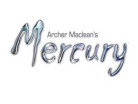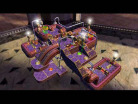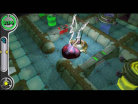- CLASSIC MAGAZINES
- REVIEW CREW
A show recapping what critics thought back
when classic games first came out! - NEXT GENERATION'S BEST & WORST
From the worst 1-star reviews to the best
5-stars can offer, this is Next Generation! - NINTENDO POWER (ARCHIVE)
Experience a variety of shows looking at the
often baffling history of Nintendo Power! - MAGAZINE RETROSPECTIVE
We're looking at the absolutely true history of
some of the most iconic game magazines ever! - SUPER PLAY'S TOP 600
The longest and most ambitious Super NES
countdown on the internet! - THEY SAID WHAT?
Debunking predictions and gossip found
in classic video game magazines! - NEXT GENERATION UNCOVERED
Cyril is back in this spin-off series, featuring the
cover critic review the art of Next Generation! - HARDCORE GAMER MAGAZING (PDF ISSUES)
Download all 36 issues of Hardcore Gamer
Magazine and relive the fun in PDF form!
- REVIEW CREW
- ELECTRONIC GAMING MONTHLY
- ELECTRONIC GAMING MONTHLY RANKS
From Mario to Sonic to Street Fighter, EGM
ranks classic game franchises and consoles! - ELECTRONIC GAMING MONTHLY BEST & WORST
Counting down EGM’s best and worst reviews
going year by year, from 1989 – 2009! - ELECTRONIC GAMING BEST & WORST AWARDS
11-part video series chronicling the ups and
downs of EGM’s Best & Worst Awards!
- ELECTRONIC GAMING MONTHLY RANKS
- GAME HISTORY
- GAME OVER: STORY BREAKDOWNS
Long-running series breaking down game
stories and analyzing their endings! - A BRIEF HISTORY OF GAMING w/ [NAME HERE]
Real history presented in a fun and pithy
format from a variety of game historians! - THE BLACK SHEEP
A series looking back at the black sheep
entries in popular game franchises! - INSTANT EXPERT
Everything you could possibly want to know
about a wide variety of gaming topics! - FREEZE FRAME
When something familiar happens in the games
industry, we're there to take a picture! - I'VE GOT YOUR NUMBER
Learn real video game history through a series
of number-themed episodes, starting at zero! - GREAT MOMENTS IN BAD ACTING
A joyous celebration of some of gaming's
absolute worst voice acting!
- GAME OVER: STORY BREAKDOWNS
- POPULAR SHOWS
- DG NEWS w/ LORNE RISELEY
Newsman Lorne Riseley hosts a regular
series looking at the hottest gaming news! - REVIEW REWIND
Cyril replays a game he reviewed 10+ years
ago to see if he got it right or wrong! - ON-RUNNING FEUDS
Defunct Games' longest-running show, with
editorials, observations and other fun oddities! - DEFUNCT GAMES QUIZ (ARCHIVE)
From online quizzes to game shows, we're
putting your video game knowledge to the test!- QUIZ: ONLINE PASS
Take a weekly quiz to see how well you know
the news and current gaming events! - QUIZ: KNOW THE GAME
One-on-one quiz show where contestants
find out if they actually know classic games! - QUIZ: THE LEADERBOARD
Can you guess the game based on the classic
review? Find out with The Leaderboard!
- QUIZ: ONLINE PASS
- DEFUNCT GAMES VS.
Cyril and the Defunct Games staff isn't afraid
to choose their favorite games and more! - CYRIL READS WORLDS OF POWER
Defunct Games recreates classic game
novelizations through the audio book format!
- DG NEWS w/ LORNE RISELEY
- COMEDY
- GAME EXPECTANCY
How long will your favorite hero live? We crunch
the numbers in this series about dying! - VIDEO GAME ADVICE
Famous game characters answer real personal
advice questions with a humorous slant! - FAKE GAMES: GUERILLA SCRAPBOOK
A long-running series about fake games and
the people who love them (covers included)! - WORST GAME EVER
A contest that attempts to create the worst
video game ever made, complete with covers! - LEVEL 1 STORIES
Literature based on the first stages of some
of your favorite classic video games! - THE COVER CRITIC
One of Defunct Games' earliest shows, Cover
Critic digs up some of the worst box art ever! - COMMERCIAL BREAK
Take a trip through some of the best and
worst video game advertisements of all time! - COMIC BOOK MODS
You've never seen comics like this before.
A curious mix of rewritten video game comics!
- GAME EXPECTANCY
- SERIES ARCHIVE
- NINTENDO SWITCH ONLINE ARCHIVE
A regularly-updated list of every Nintendo
Switch Online release, plus links to review! - PLAYSTATION PLUS CLASSIC ARCHIVE
A comprehensive list of every PlayStation
Plus classic release, including links! - RETRO-BIT PUBLISHING ARCHIVE
A regularly-updated list of every Retro-Bit
game released! - REVIEW MARATHONS w/ ADAM WALLACE
Join critic Adam Wallace as he takes us on a
classic review marathon with different themes!- DEFUNCT GAMES GOLF CLUB
Adam Wallace takes to the links to slice his way
through 72 classic golf game reviews! - 007 IN PIXELS
Adam Wallace takes on the world's greatest spy
as he reviews 15 weeks of James Bond games! - A SALUTE TO VAMPIRES
Adam Wallace is sinking his teeth into a series
covering Castlevania, BloodRayne and more! - CAPCOM'S CURSE
Adam Wallace is celebrating 13 days of Halloween
with a line-up of Capcom's scariest games! - THE FALL OF SUPERMAN
Adam Wallace is a man of steel for playing
some of the absolute worst Superman games! - THE 31 GAMES OF HALLOWEEN
Adam Wallace spends every day of October afraid
as he reviews some of the scariest games ever! - 12 WEEKS OF STAR TREK
Adam Wallace boldly goes where no critic has
gone before in this Star Trek marathon!
- DEFUNCT GAMES GOLF CLUB
- DAYS OF CHRISTMAS (ARCHIVE)
Annual holiday series with themed-episodes
that date all the way back to 2001!- 2015: 30 Ridiculous Retro Rumors
- 2014: 29 Magazines of Christmas
- 2013: 29 Questionable Power-Ups of Christmas
- 2012: 34 Theme Songs of Christmas
- 2011: 32 Game Endings of Christmas
- 2010: 31 Bonus Levels of Christmas
- 2009: 30 Genres of Christmas
- 2008: 29 Controls of Christmas
- 2007: 34 Cliches of Christmas
- 2006: 33 Consoles of Christmas
- 2005: 32 Articles of Christmas
- 2004: 31 Websites of Christmas
- 2003: 29 Issues of Christmas
- 2002: 28 Years of Christmas
- 2001: 33 Days of Christmas
- NINTENDO SWITCH ONLINE ARCHIVE
- REVIEW ARCHIVE
- FULL ARCHIVE
Archer Maclean's Mercury
Archer Maclean is no stranger to the world of addictive games, so it probably shouldn't come as any surprise that the back of the Mercury box boasts it is "possibly the most addictive game you'll ever play!" As a fan of Mr. Maclean's work, and a guy who doesn't mind being addicted to a game, I was ready to see if Mercury would really be more addictive than games like Tetris, Lumines, and so many others.
Mercury is a quirky little game that requires a lot of patience, a steady hand, and more than a little time on your hands. At first it seems almost too easy, your goals being nothing more than to get your blob of shiny liquid metal to the checkpoint before the time runs out. But soon you have to do more than negotiate tough corners, you'll have to mix colors, solve puzzles, and work with several blobs of metal at the same time.
Instead of actually taking control of the blobs of metal you control the table they are sitting on, which means that you have to tilt the board in order for any movement to occur. You tilt the table using the PSP's analog nub with the face buttons manipulating the camera angle; this set up works extremely well and takes full advantage of just about every button found on Sony's handheld. Since few games require players to use the analog nub some players may have to get used to the control scheme, but with a little practice you'll be controlling the board like a pro.
The levels are split up into a few different types of games, most of which revolve around the basic goal of getting to the end before time runs out. In the race levels you generally don't have to worry about how much of your blob you lose, just as long as you get to the end in time. In contrast, the percentage stages require you to keep your blob intact, because if you lose too much before crossing the finish line you won't move on. The task levels are slightly different, generally requiring you to solve a puzzle before you can finish the level. Beyond those three, there are combo stages and boss stages, all of which will require you to be a master of speed, timing, and problem solving.
Mercury is split up into six different worlds, each housing 12 separate levels. These different worlds are all represented by a theme, from snow and ice in Xero, to water in Aqua, to fire and lava in Nano. In each of these worlds the designs use different tiles and types of obstacles, giving some personality to the stages. Each world also offers a rather interesting cinema for you to watch, one that you can view at any time thanks to the theater option (something that seemed awfully strange for a puzzle game).
The real reason to continue playing Mercury is not to see some CGI effect or what the next level's gimmick is going to be, the real reason to keep going is to see what kind of crazy maze they are going to come up with next. It might seem like it at first, but Mercury has some of the best level designs you will see for this type of game. In some of the later levels you really are dealing with some massive tasks that reminded me a lot of old Rube Goldberg inventions. With nearly 100 levels, if you really get into the puzzle solving and precision that is required to complete the game you will have plenty to keep yourself entertained for months to come.
Unfortunately I didn't find it all that appealing after awhile. Even with the large amount of levels and variety, I still couldn't shake the feeling that this was all very repetitive. To me Mercury had a lot in common with Lemmings, where the theme is a lot of fun, but since you are always doing the same thing in every level it just starts to feel futile after awhile. This is the type of game I can see somebody picking away at over a long period of time, but not all at once.
There is a two-player mode that allows you and a friend to race against each other on any one of the game's levels. While this mode can lead to some tight races, most of the levels don't really feel like they were designed for this in mind, and something about the theme don't rub off with multiple people. Part of the problem is that this mode feels tacked on, like it was a last minute feature to take part of the whole Wi Fi excitement. It's worth noting that the box suggests that the game can be played online via the Infrastructure mode, but that is not the case, as Ad Hoc is the only mode I found in my copy.
We already knew the PSP is capable of amazing graphics, but I was still impressed with the visual look of Mercury. Not only are the backgrounds interesting and unique, but each table features a lot of extra detail that gives it a very stylish look. As you move from one table to the next you will find all kinds of effects and obstacles that really shine on the PSP screen.
It's easy to see how somebody could really get into Mercury; it's a challenging game that always seems to offer something new and original in every level. I enjoyed the way the game played, but found myself growing tired of it before too long. For me it would seem that it was not the most addictive game I have ever played, but that's not to say that it doesn't have an audience that will appreciate it for what it is. I got sucked in for awhile, but the trial and error game play and non-stop mazes wore me out.
HOME |
CONTACT |
NOW HIRING |
WHAT IS DEFUNCT GAMES? |
NINTENDO SWITCH ONLINE |
RETRO-BIT PUBLISHING
Retro-Bit |
Switch Planet |
The Halcyon Show |
Same Name, Different Game |
Dragnix |
Press the Buttons
Game Zone Online | Hardcore Gamer | The Dreamcast Junkyard | Video Game Blogger
Dr Strife | Games For Lunch | Mondo Cool Cast | Boxed Pixels | Sega CD Universe | Gaming Trend
Game Zone Online | Hardcore Gamer | The Dreamcast Junkyard | Video Game Blogger
Dr Strife | Games For Lunch | Mondo Cool Cast | Boxed Pixels | Sega CD Universe | Gaming Trend
Copyright © 2001-2025 Defunct Games
All rights reserved. All trademarks are properties of their respective owners.
All rights reserved. All trademarks are properties of their respective owners.





























